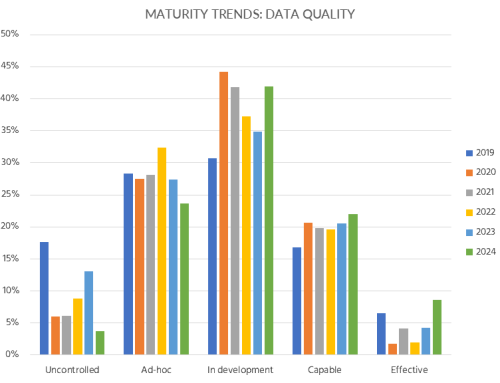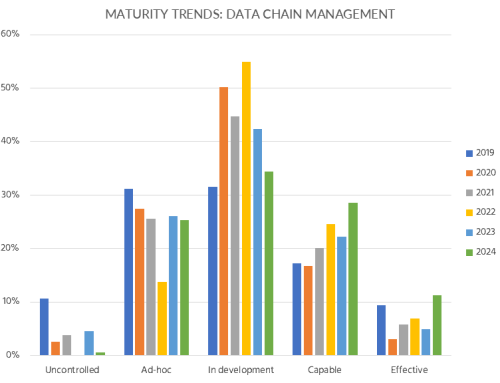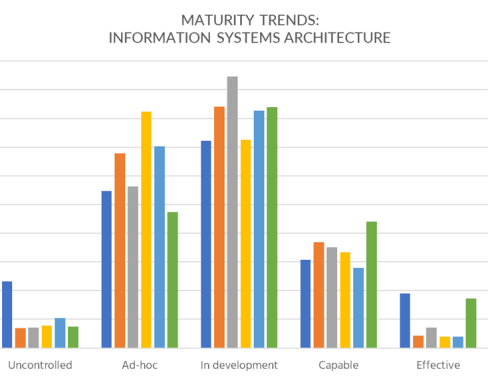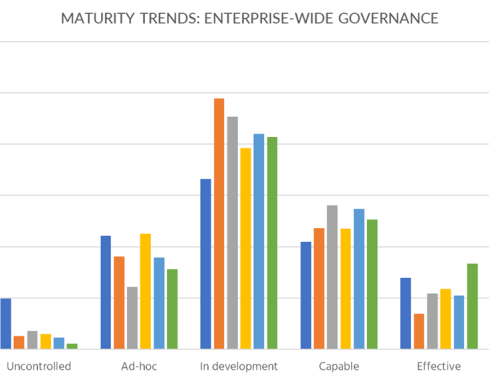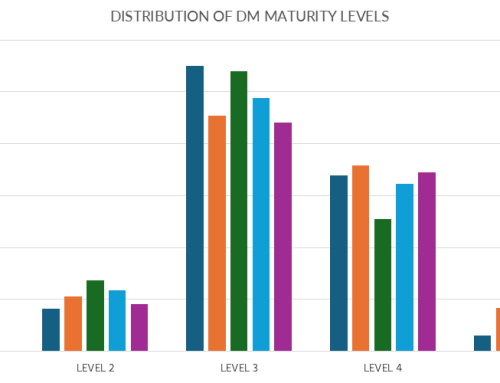This article discusses the trends in data modelling maturity.
This is the third article in the series Tracking Data Management Maturity: A Five-Year Perspective (2019–2024).
Its purpose is to examine the evolving trends in the data modelling capability, and to introduce a new approach to measuring maturity based on the outcomes of these capabilities.
If interested, you can benchmark your organization’s results by performing the Data Crossroads free maturity scan.
In this article, we will:
- Define the data modelling capability within the context of the O.R.A.N.G.E. Data Management Framework, including its goals and key outcomes
- Highlight five-year trends in the development of this capability and its underlying components
- Provide practical recommendations for further strengthening data modelling maturity
Let’s begin by defining what the data modelling capability for data management entails, along with its goals and measurable outcomes.
Data Modelling
Challenges
The key challenge with this capability is that it has not been uniquely defined across the leading industry guidelines, including DAMA-DMBOK2, DCAM®, CDMC™, and the TOGAF® Standard (see Figure 1).
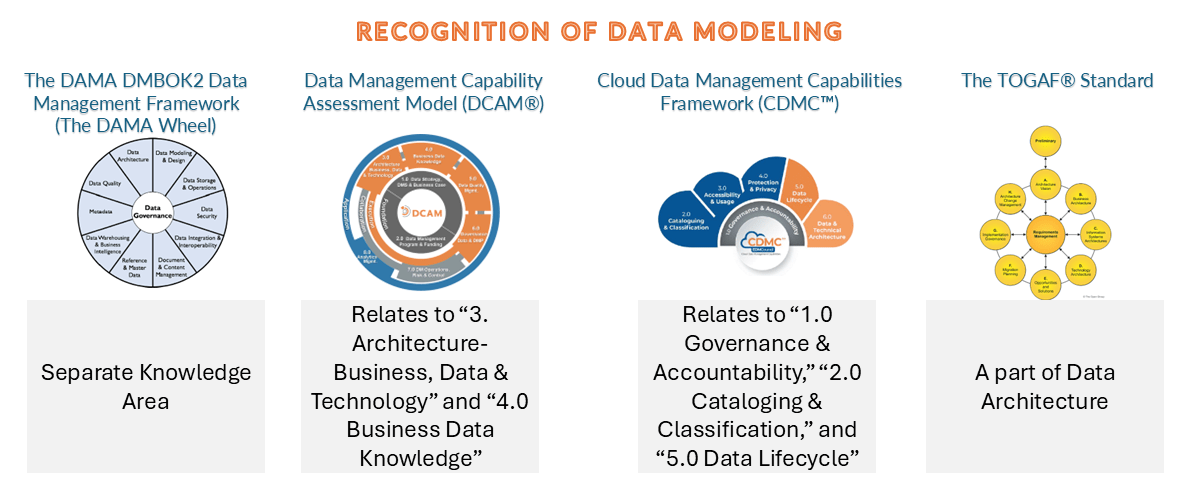
Figure 1: Data modelling capability across industry guidelines.
DAMA-DMBOK2 recognizes it as a separate Knowledge Area and defines it as the “process of discovering, analyzing, and scoping data requirements and communicating these data requirements in a precise form called data models.”
Two guidelines of the EDM Association, DCAM® and CDMC™, don’t separate this capability and relate it to several other components of these models.
The TOGAF® Standard, the leading enterprise architecture framework, considers data models as the deliverables of data architecture.
This challenge leads to one obvious conclusion: each organization must identify the status of this capability within its framework.
Let’s agree on the definition of this capability within the context of the article.
Definition
The O.R.A.N.G.E. Data Management Framework, which I’ve developed, applies the following definition, which partly reuses the definition provided by the DAMA Dictionary:
Data modelling capability is a company’s ability to deliver, maintain, and manage data models to “[…] a) define and analyze data requirements, b) design logical and physical structures that support these requirements, and c) define business and technical meta-data.”
The O.R.A.N.G.E. framework aligns with the TOGAF® recommendations and views data modelling as a sub-capability of data architecture, as illustrated in Figure 2.
Data Modelling Capability: Purpose, Outcomes, and Capability Components
The purpose of a capability represents its high-level aspiration—it answers the question: “Why does this capability exist?” It is stable over time and cannot be directly measured.
For the data modelling governance capability, the purpose can be defined as follows:
Enable the organization to define, standardize, structure, and communicate data requirements in a way that supports business operations, technical implementation, and data governance. It ensures that data is represented clearly and consistently, allowing it to be designed, used, and reused effectively across systems, domains, and use cases.
To assess whether this purpose is being fulfilled, we rely on outcomes—measurable results that demonstrate progress toward the purpose. Outcomes answer the question: “What measurable result indicates success?”
Examples of outcomes for the above purpose include:
- Clarity in data requirements and relationships
Data modelling facilitates the structured identification and visualization of data requirements, relationships, and groupings, ensuring a shared understanding among stakeholders. - Design of scalable, standardized, and interoperable data structures
Conceptual, logical, and physical models link business semantics to technical implementation, providing standardized designs for databases, data services, integration, and analytics that scale and interoperate. - Improved communication and data & metadata integration
Data models serve as a common language that drives the integration of both data and metadata, linking business and IT while embedding definitions, ownership, and lineage to support governance, compliance, and explainability.
Although the capability defines what the organization must do, practitioners also need to understand how, when, and where it should be done. Seven components that enable each business capability not only support measurement—they also operationalize the capability into a functioning business discipline.
Figure 3 illustrates these components and shows how they link to the overall governance capability.
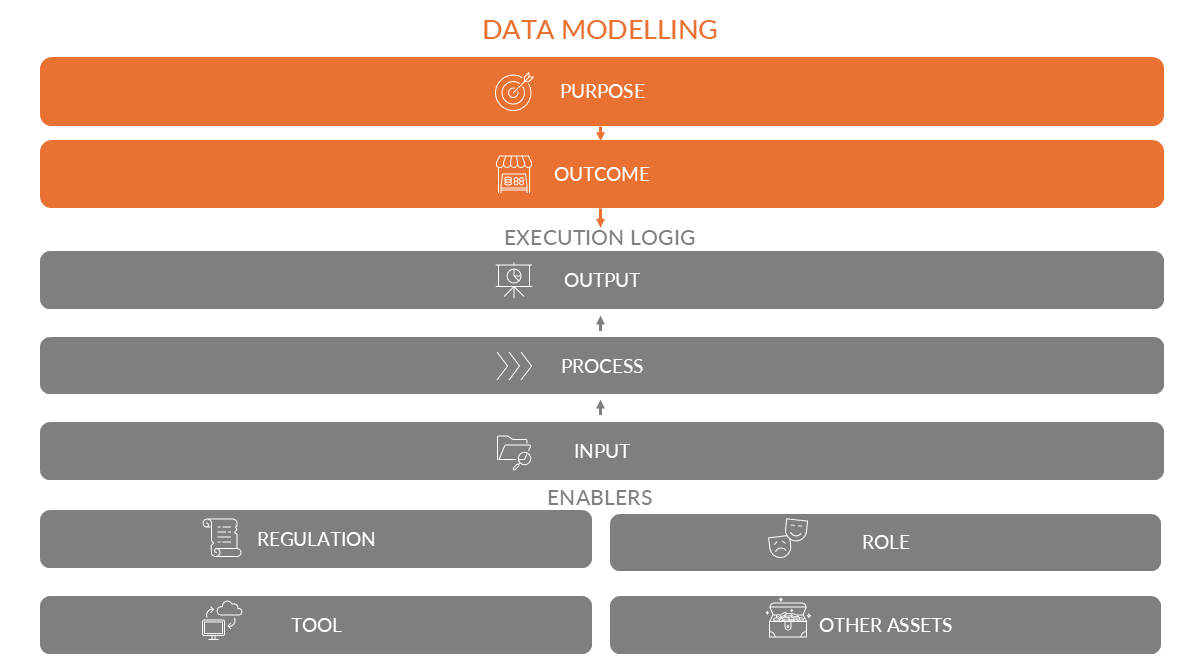
Figure 3: Approach to operationalizing data modelling capability.
Designing the data modelling capability starts with a clear definition of its purpose—the strategic aspiration it aims to fulfill. Progress toward that purpose is measured through outcomes, which reflect whether the intended value is being delivered.
Each outcome is supported by one or more outputs—the concrete deliverables that signal progress. These outputs result from processes that act on specific inputs, forming the operational core of the capability.
To enable this flow, several components must be in place: regulations to guide activity, roles to carry it out, IT tools for automation, and other supporting assets. While these elements don’t produce outcomes directly, they ensure consistent execution—allowing outputs to be delivered and outcomes achieved.
With this structure in mind, let’s examine how the data modelling capability has evolved over the past five years.
Data Modelling Capability: 5-Year Trends
The maturity trend for the data modelling capability between 2019 and 2024 shows steady progress, particularly in the transition from “in development” to “capable” maturity, as shown in Figure 4.
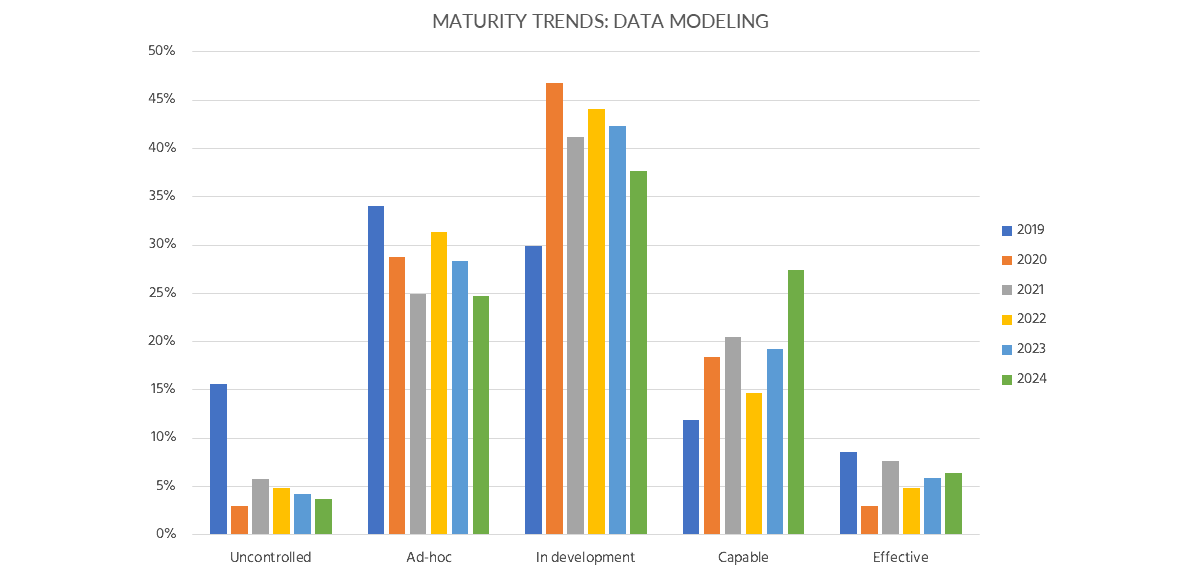
Figure 4: Trends in developing the data modelling capability.
While the “in development” level remains the most common in 2024, its dominance has started to decline as more organizations adopt structured modelling practices. At the same time, the share of organizations reaching the “capable” stage has grown, indicating an improved ability to design, manage, and maintain data models through formal roles, tools, and standards.
Lower maturity levels, such as “uncontrolled” and “ad-hoc,” continue to decrease, suggesting that unstructured approaches are becoming less common. However, the number of organizations achieving the “effective” level has remained relatively flat. These trends indicate that, while structural improvements are underway, the enterprise-wide institutionalization of data modelling as a repeatable and value-generating capability remains limited.
As discussed earlier, several outcomes can confirm and help measure the purpose’s achievements. However, delivering these outcomes requires the combination of several capability components and particular outputs working together. Therefore, the maturity assessment has been performed for several capability outputs.
Let me demonstrate the trends in their development.
Indicator 1: Business Glossary
The maturity trend for the business glossary indicator between 2019 and 2024 reflects modest but steady progress, as shown in Figure 5.
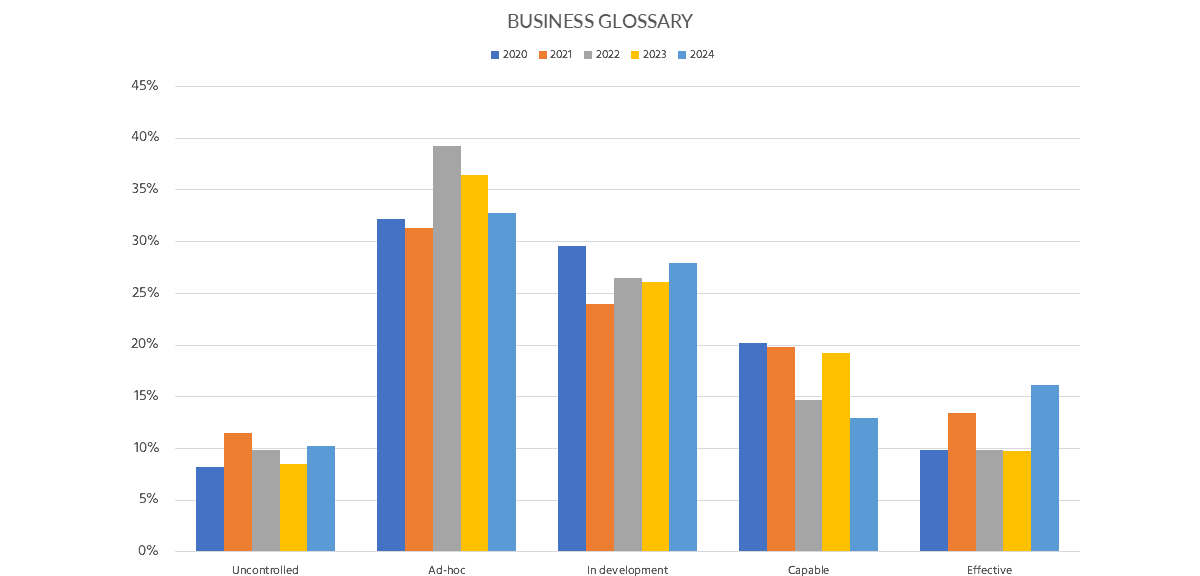
Figure 5: Trends for the indicator “Business Glossary.”
The number of organizations operating at the “ad-hoc” level has gradually declined, as more begin to recognize the importance of standardized terminology in supporting data consistency and shared understanding. By 2024, growth in both the “in development” and “effective” categories suggests that glossary practices are becoming more formalized.
While many organizations still rely on informal or fragmented definitions, the gradual rise in maturity indicates an increasing effort to structure, manage, and consistently apply business terms. Overall, the trend suggests a gradual yet ongoing shift from the isolated use of terminology to a more coordinated and governed approach to business glossaries.
Indicator 2: Data Models
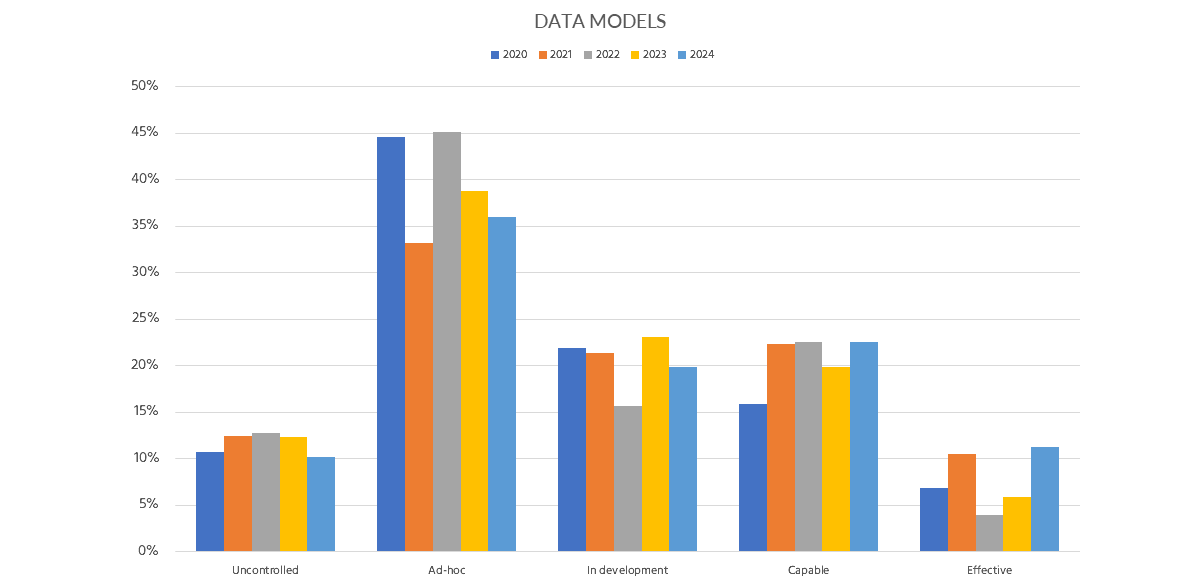
Figure 6: Trends for the indicator “Data models.”
The maturity trend for the data models indicator shows a gradual improvement from 2020 to 2024 (see Figure 6).
Although the majority of organizations still operate at the “ad-hoc” level, this group has slowly declined over time, indicating a shift away from unstructured or one-off modeling practices. In parallel, there has been a modest but steady increase in the number of organizations reaching the “capable” and “effective” levels.
This trend suggests growing attention to the development, maintenance, and use of data models as a means to represent data structures and relationships more consistently. While formal modelling practices are not yet widespread, the data points to a continued movement toward more repeatable and governed approaches.
Indicator 3: Information and Data Requirements
The maturity trend for the data and information requirements indicator, as shown in Figure 7, demonstrates a gradual yet consistent improvement from 2020 to 2024.
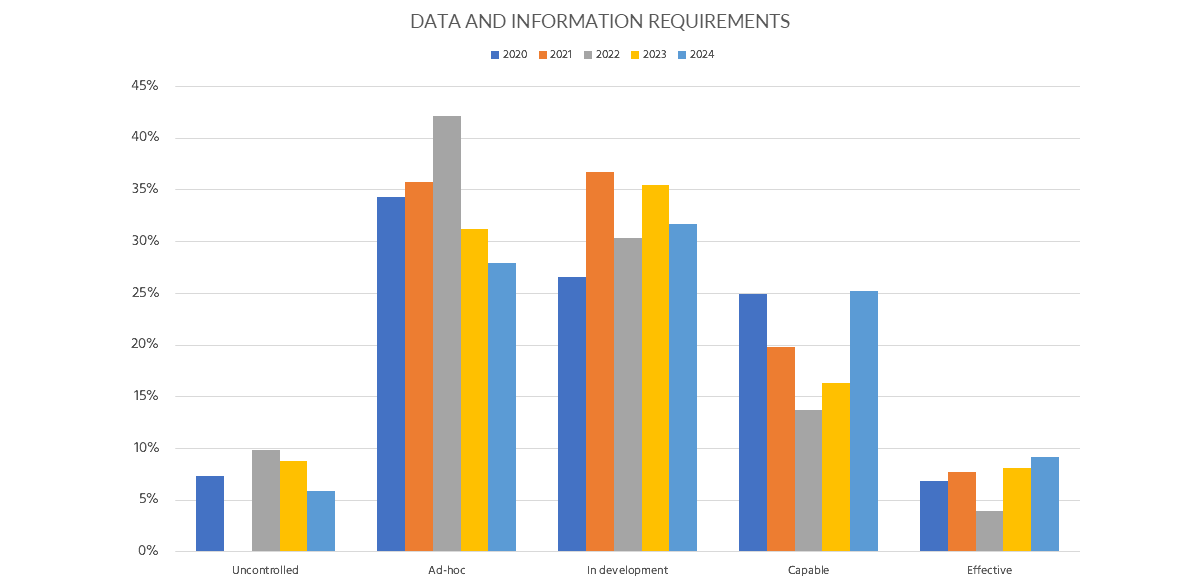
Figure 7: Trends for the indicator “Data and information requirements.”
Organizations are increasingly moving away from ad-hoc approaches to capturing information and data requirements. The number of organizations in the “capable” category has rebounded, and there is a gradual rise in those reaching the “effective” level, indicating that more formal practices are being implemented to consistently manage data requirements.
While the majority still operate at lower or transitional levels, the overall trend reflects a growing recognition of the need to clearly document data requirements and maintain them as part of broader data management and solution design processes.
Indicator 4: Critical Data
The maturity trend for the critical data indicator reflects consistent, though gradual, improvement between 2020 and 2024, as demonstrated in Figure 8.
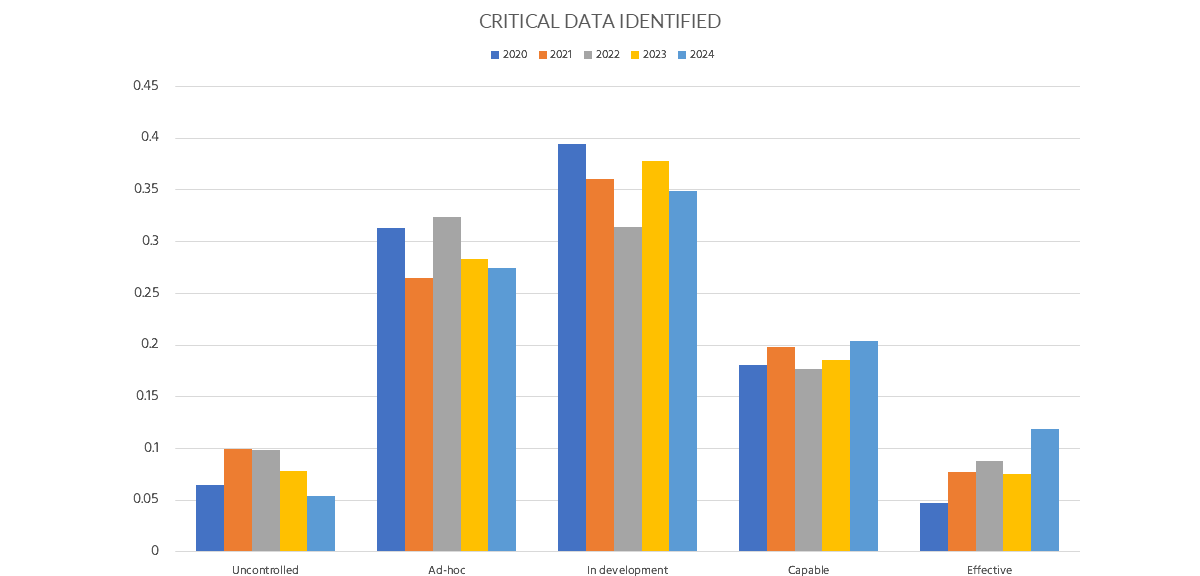
Figure 8: Trends for the indicator “Critical data identified.”
Most organizations continue to operate at the “in development” level, where efforts to identify and define critical data elements are underway but not yet fully formalized. However, the share of organizations reaching the “capable” and “effective” levels has continued to grow—indicating a steady shift toward more structured practices.
This trend suggests that while many organizations are still building the foundations, there is increasing recognition of the need to formally identify, document, and govern the data elements most essential to business operations.
Summary and Recommendations
The O.R.A.N.G.E. Data Management Framework applies a capability-based structure to assess and develop data modelling maturity—linking the capability’s purpose to its intended outcomes, measurable outputs, and the components required to sustain it.
Maturity trends from 2019 to 2024 indicate steady progress, with organizations gradually shifting from ad-hoc modelling efforts to more standardized, repeatable practices. While foundational elements—such as modelling roles, tools, and design standards—are increasingly adopted, full enterprise-wide integration and value realization remain limited.
To advance the development of the data modelling capability:
- Define the purpose and outcomes of data modelling
An organization should articulate how data modelling supports both business operations and technical implementation—clarifying its role in ensuring data consistency, reusability, and governance. - Establish foundational components
Core elements, such as modeling standards, role definitions, metadata integration, and modeling tools, should be formalized to ensure the consistent delivery of high-quality outputs. - Promote enterprise-wide adoption
Data modelling should be embedded into solution development lifecycles, architectural practices, and governance structures—moving beyond isolated project use. - Track maturity and performance over time
A structured approach to measuring progress—using capability-specific indicators and defined KPIs—can help identify gaps, prioritize improvements, and demonstrate value. - Enhance business-IT collaboration
Position data models as a communication bridge between stakeholders by emphasizing their role in defining shared semantics, clarifying requirements, and supporting cross-functional initiatives.


